Genetic Counseling Report: Causes, Reactions, and Management Plan
VerifiedAdded on 2023/04/21
|6
|1478
|241
Report
AI Summary
This report delves into the crucial aspects of genetic counseling, emphasizing its significance in addressing the health concerns of families at risk of transmitting genetic diseases. The report uses a case study of a 34-year-old female with two affected sons, exploring the causes of genetic counseling, including prevention, screening, family history, and diagnostics. It further examines the patient's potential reactions to counseling, and strategies to mitigate negative responses. The report outlines the counseling process, from building rapport to delivering diagnoses and prognoses, and emphasizes the importance of a tailored management plan. The report also addresses the potential for negative patient reactions and suggests interventions, such as involving psychologists, to ensure effective counseling outcomes. The effectiveness of counseling, contingent on the counselor's skills in providing unconditional positive regard, building rapport, and alleviating patient anxieties through proper guidance, is also discussed.
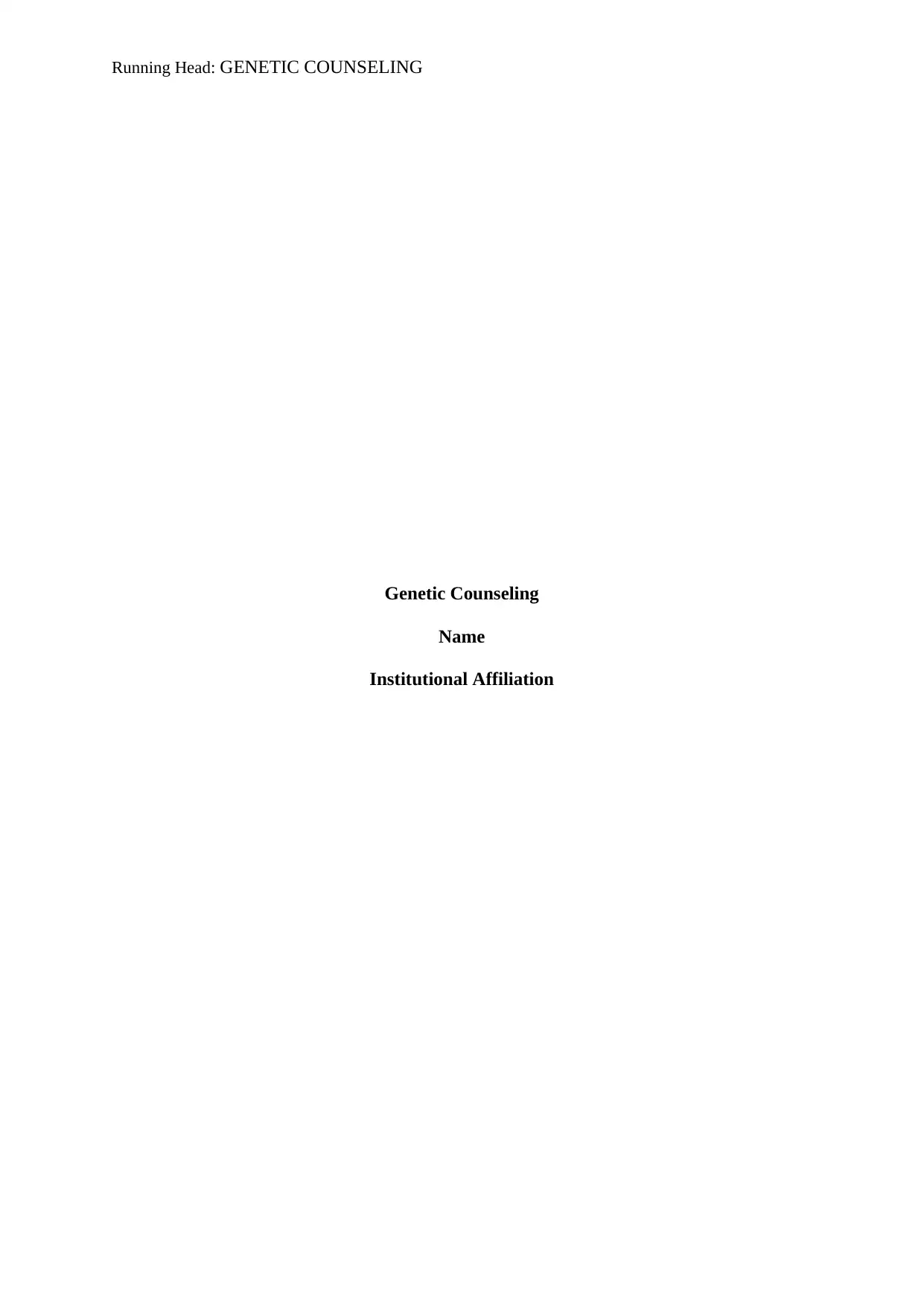
Running Head: GENETIC COUNSELING
Genetic Counseling
Name
Institutional Affiliation
Genetic Counseling
Name
Institutional Affiliation
Paraphrase This Document
Need a fresh take? Get an instant paraphrase of this document with our AI Paraphraser
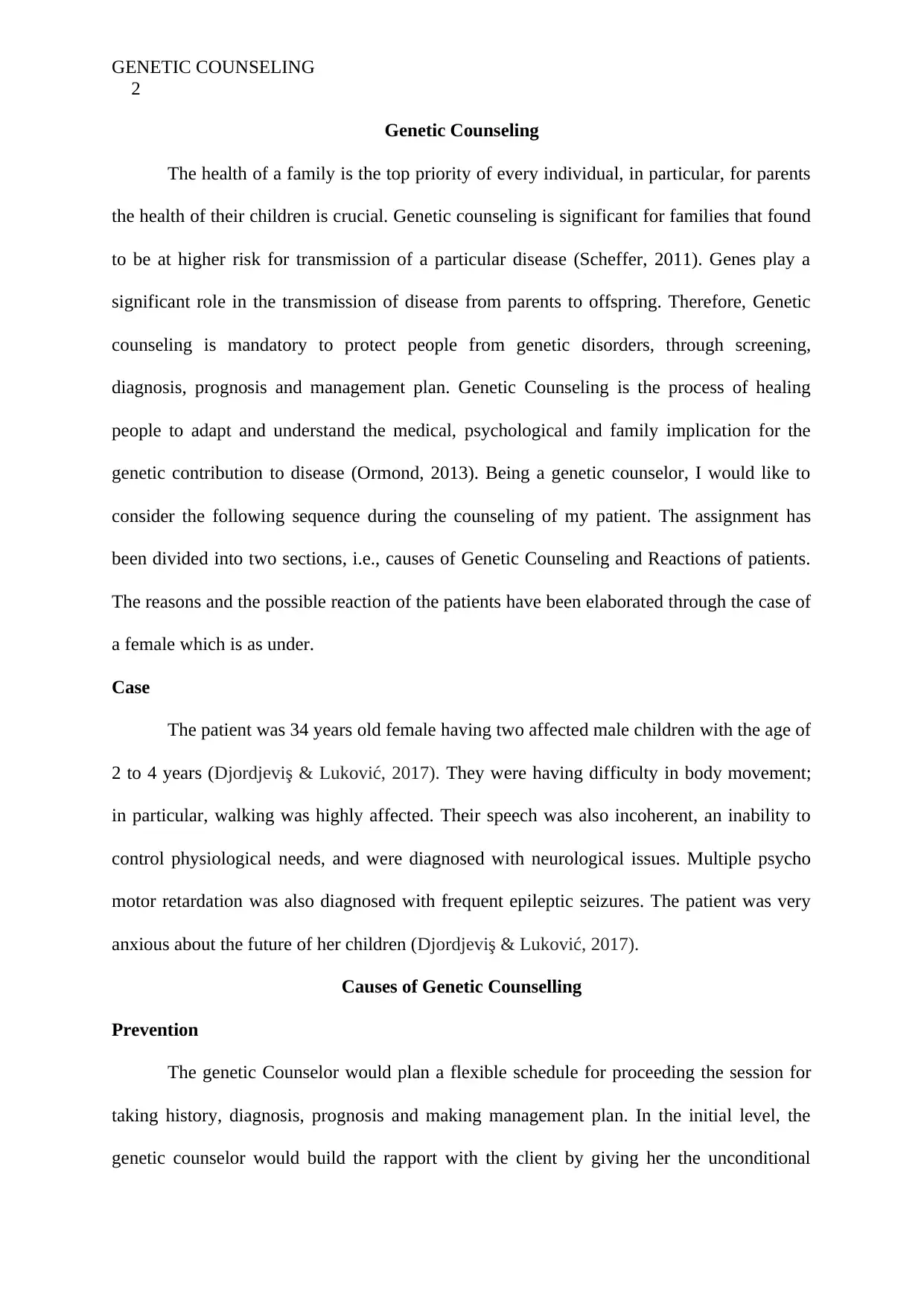
GENETIC COUNSELING
2
Genetic Counseling
The health of a family is the top priority of every individual, in particular, for parents
the health of their children is crucial. Genetic counseling is significant for families that found
to be at higher risk for transmission of a particular disease (Scheffer, 2011). Genes play a
significant role in the transmission of disease from parents to offspring. Therefore, Genetic
counseling is mandatory to protect people from genetic disorders, through screening,
diagnosis, prognosis and management plan. Genetic Counseling is the process of healing
people to adapt and understand the medical, psychological and family implication for the
genetic contribution to disease (Ormond, 2013). Being a genetic counselor, I would like to
consider the following sequence during the counseling of my patient. The assignment has
been divided into two sections, i.e., causes of Genetic Counseling and Reactions of patients.
The reasons and the possible reaction of the patients have been elaborated through the case of
a female which is as under.
Case
The patient was 34 years old female having two affected male children with the age of
2 to 4 years (Djordjeviş & Luković, 2017). They were having difficulty in body movement;
in particular, walking was highly affected. Their speech was also incoherent, an inability to
control physiological needs, and were diagnosed with neurological issues. Multiple psycho
motor retardation was also diagnosed with frequent epileptic seizures. The patient was very
anxious about the future of her children (Djordjeviş & Luković, 2017).
Causes of Genetic Counselling
Prevention
The genetic Counselor would plan a flexible schedule for proceeding the session for
taking history, diagnosis, prognosis and making management plan. In the initial level, the
genetic counselor would build the rapport with the client by giving her the unconditional
2
Genetic Counseling
The health of a family is the top priority of every individual, in particular, for parents
the health of their children is crucial. Genetic counseling is significant for families that found
to be at higher risk for transmission of a particular disease (Scheffer, 2011). Genes play a
significant role in the transmission of disease from parents to offspring. Therefore, Genetic
counseling is mandatory to protect people from genetic disorders, through screening,
diagnosis, prognosis and management plan. Genetic Counseling is the process of healing
people to adapt and understand the medical, psychological and family implication for the
genetic contribution to disease (Ormond, 2013). Being a genetic counselor, I would like to
consider the following sequence during the counseling of my patient. The assignment has
been divided into two sections, i.e., causes of Genetic Counseling and Reactions of patients.
The reasons and the possible reaction of the patients have been elaborated through the case of
a female which is as under.
Case
The patient was 34 years old female having two affected male children with the age of
2 to 4 years (Djordjeviş & Luković, 2017). They were having difficulty in body movement;
in particular, walking was highly affected. Their speech was also incoherent, an inability to
control physiological needs, and were diagnosed with neurological issues. Multiple psycho
motor retardation was also diagnosed with frequent epileptic seizures. The patient was very
anxious about the future of her children (Djordjeviş & Luković, 2017).
Causes of Genetic Counselling
Prevention
The genetic Counselor would plan a flexible schedule for proceeding the session for
taking history, diagnosis, prognosis and making management plan. In the initial level, the
genetic counselor would build the rapport with the client by giving her the unconditional
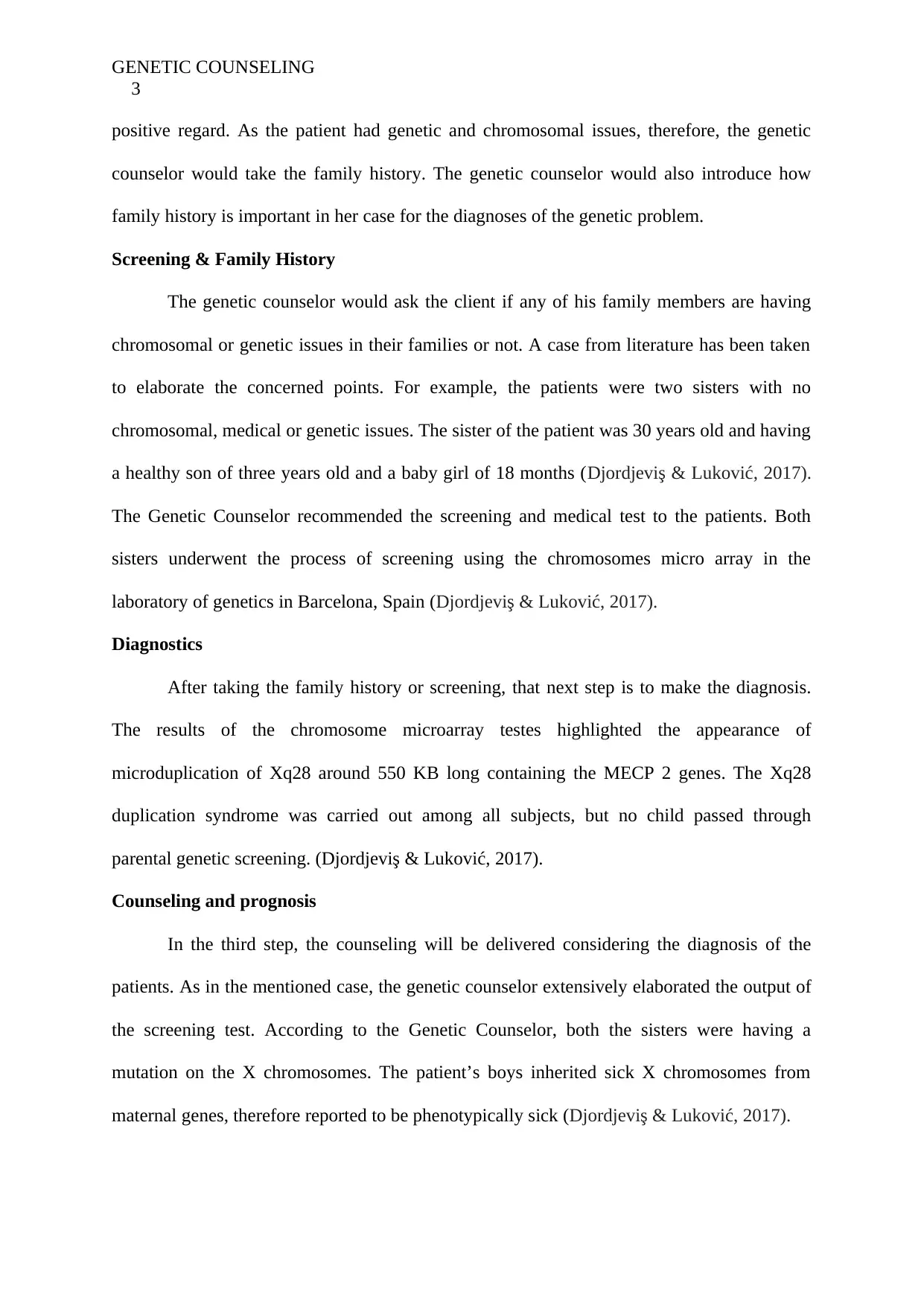
GENETIC COUNSELING
3
positive regard. As the patient had genetic and chromosomal issues, therefore, the genetic
counselor would take the family history. The genetic counselor would also introduce how
family history is important in her case for the diagnoses of the genetic problem.
Screening & Family History
The genetic counselor would ask the client if any of his family members are having
chromosomal or genetic issues in their families or not. A case from literature has been taken
to elaborate the concerned points. For example, the patients were two sisters with no
chromosomal, medical or genetic issues. The sister of the patient was 30 years old and having
a healthy son of three years old and a baby girl of 18 months (Djordjeviş & Luković, 2017).
The Genetic Counselor recommended the screening and medical test to the patients. Both
sisters underwent the process of screening using the chromosomes micro array in the
laboratory of genetics in Barcelona, Spain (Djordjeviş & Luković, 2017).
Diagnostics
After taking the family history or screening, that next step is to make the diagnosis.
The results of the chromosome microarray testes highlighted the appearance of
microduplication of Xq28 around 550 KB long containing the MECP 2 genes. The Xq28
duplication syndrome was carried out among all subjects, but no child passed through
parental genetic screening. (Djordjeviş & Luković, 2017).
Counseling and prognosis
In the third step, the counseling will be delivered considering the diagnosis of the
patients. As in the mentioned case, the genetic counselor extensively elaborated the output of
the screening test. According to the Genetic Counselor, both the sisters were having a
mutation on the X chromosomes. The patient’s boys inherited sick X chromosomes from
maternal genes, therefore reported to be phenotypically sick (Djordjeviş & Luković, 2017).
3
positive regard. As the patient had genetic and chromosomal issues, therefore, the genetic
counselor would take the family history. The genetic counselor would also introduce how
family history is important in her case for the diagnoses of the genetic problem.
Screening & Family History
The genetic counselor would ask the client if any of his family members are having
chromosomal or genetic issues in their families or not. A case from literature has been taken
to elaborate the concerned points. For example, the patients were two sisters with no
chromosomal, medical or genetic issues. The sister of the patient was 30 years old and having
a healthy son of three years old and a baby girl of 18 months (Djordjeviş & Luković, 2017).
The Genetic Counselor recommended the screening and medical test to the patients. Both
sisters underwent the process of screening using the chromosomes micro array in the
laboratory of genetics in Barcelona, Spain (Djordjeviş & Luković, 2017).
Diagnostics
After taking the family history or screening, that next step is to make the diagnosis.
The results of the chromosome microarray testes highlighted the appearance of
microduplication of Xq28 around 550 KB long containing the MECP 2 genes. The Xq28
duplication syndrome was carried out among all subjects, but no child passed through
parental genetic screening. (Djordjeviş & Luković, 2017).
Counseling and prognosis
In the third step, the counseling will be delivered considering the diagnosis of the
patients. As in the mentioned case, the genetic counselor extensively elaborated the output of
the screening test. According to the Genetic Counselor, both the sisters were having a
mutation on the X chromosomes. The patient’s boys inherited sick X chromosomes from
maternal genes, therefore reported to be phenotypically sick (Djordjeviş & Luković, 2017).
⊘ This is a preview!⊘
Do you want full access?
Subscribe today to unlock all pages.

Trusted by 1+ million students worldwide
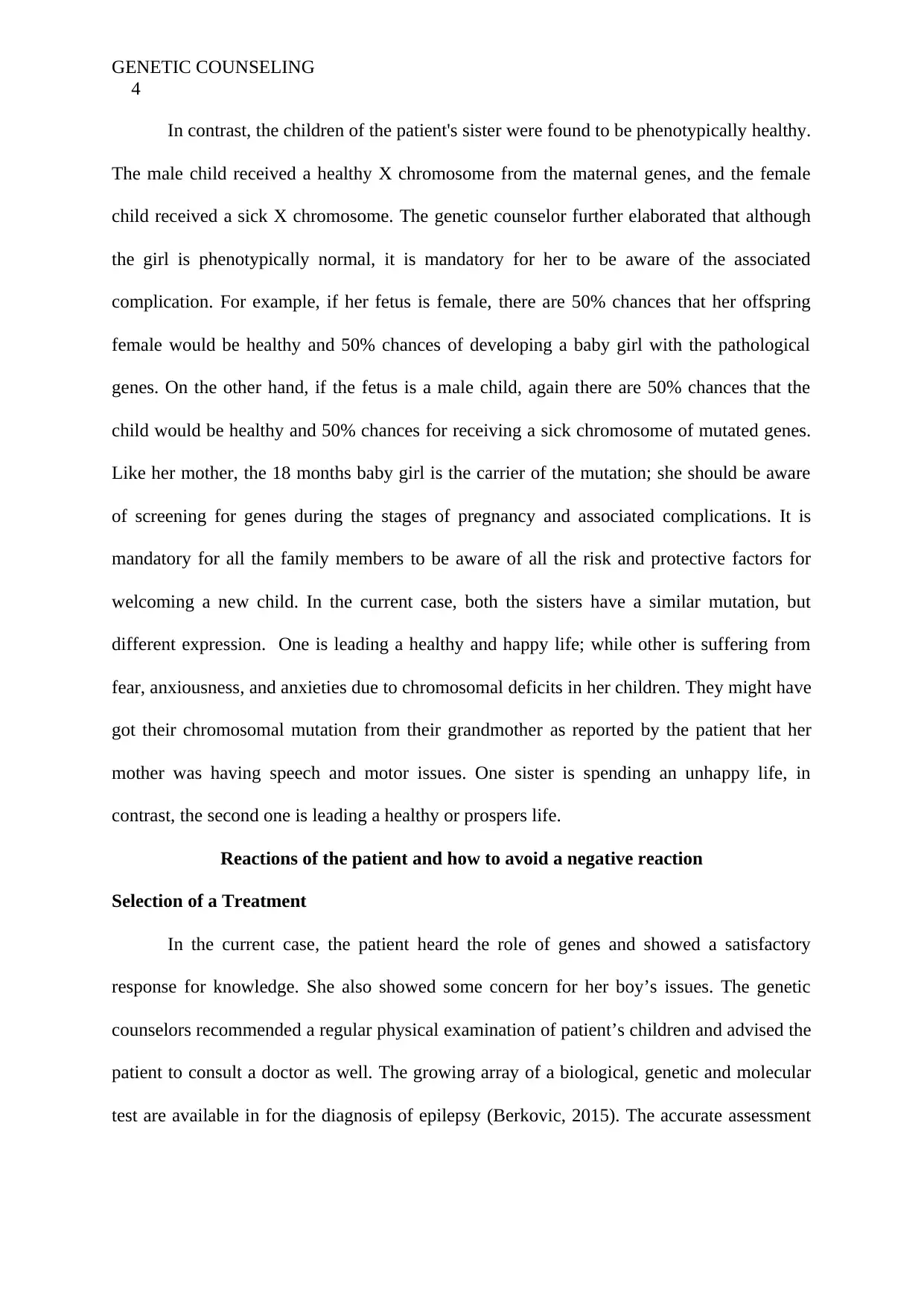
GENETIC COUNSELING
4
In contrast, the children of the patient's sister were found to be phenotypically healthy.
The male child received a healthy X chromosome from the maternal genes, and the female
child received a sick X chromosome. The genetic counselor further elaborated that although
the girl is phenotypically normal, it is mandatory for her to be aware of the associated
complication. For example, if her fetus is female, there are 50% chances that her offspring
female would be healthy and 50% chances of developing a baby girl with the pathological
genes. On the other hand, if the fetus is a male child, again there are 50% chances that the
child would be healthy and 50% chances for receiving a sick chromosome of mutated genes.
Like her mother, the 18 months baby girl is the carrier of the mutation; she should be aware
of screening for genes during the stages of pregnancy and associated complications. It is
mandatory for all the family members to be aware of all the risk and protective factors for
welcoming a new child. In the current case, both the sisters have a similar mutation, but
different expression. One is leading a healthy and happy life; while other is suffering from
fear, anxiousness, and anxieties due to chromosomal deficits in her children. They might have
got their chromosomal mutation from their grandmother as reported by the patient that her
mother was having speech and motor issues. One sister is spending an unhappy life, in
contrast, the second one is leading a healthy or prospers life.
Reactions of the patient and how to avoid a negative reaction
Selection of a Treatment
In the current case, the patient heard the role of genes and showed a satisfactory
response for knowledge. She also showed some concern for her boy’s issues. The genetic
counselors recommended a regular physical examination of patient’s children and advised the
patient to consult a doctor as well. The growing array of a biological, genetic and molecular
test are available in for the diagnosis of epilepsy (Berkovic, 2015). The accurate assessment
4
In contrast, the children of the patient's sister were found to be phenotypically healthy.
The male child received a healthy X chromosome from the maternal genes, and the female
child received a sick X chromosome. The genetic counselor further elaborated that although
the girl is phenotypically normal, it is mandatory for her to be aware of the associated
complication. For example, if her fetus is female, there are 50% chances that her offspring
female would be healthy and 50% chances of developing a baby girl with the pathological
genes. On the other hand, if the fetus is a male child, again there are 50% chances that the
child would be healthy and 50% chances for receiving a sick chromosome of mutated genes.
Like her mother, the 18 months baby girl is the carrier of the mutation; she should be aware
of screening for genes during the stages of pregnancy and associated complications. It is
mandatory for all the family members to be aware of all the risk and protective factors for
welcoming a new child. In the current case, both the sisters have a similar mutation, but
different expression. One is leading a healthy and happy life; while other is suffering from
fear, anxiousness, and anxieties due to chromosomal deficits in her children. They might have
got their chromosomal mutation from their grandmother as reported by the patient that her
mother was having speech and motor issues. One sister is spending an unhappy life, in
contrast, the second one is leading a healthy or prospers life.
Reactions of the patient and how to avoid a negative reaction
Selection of a Treatment
In the current case, the patient heard the role of genes and showed a satisfactory
response for knowledge. She also showed some concern for her boy’s issues. The genetic
counselors recommended a regular physical examination of patient’s children and advised the
patient to consult a doctor as well. The growing array of a biological, genetic and molecular
test are available in for the diagnosis of epilepsy (Berkovic, 2015). The accurate assessment
Paraphrase This Document
Need a fresh take? Get an instant paraphrase of this document with our AI Paraphraser
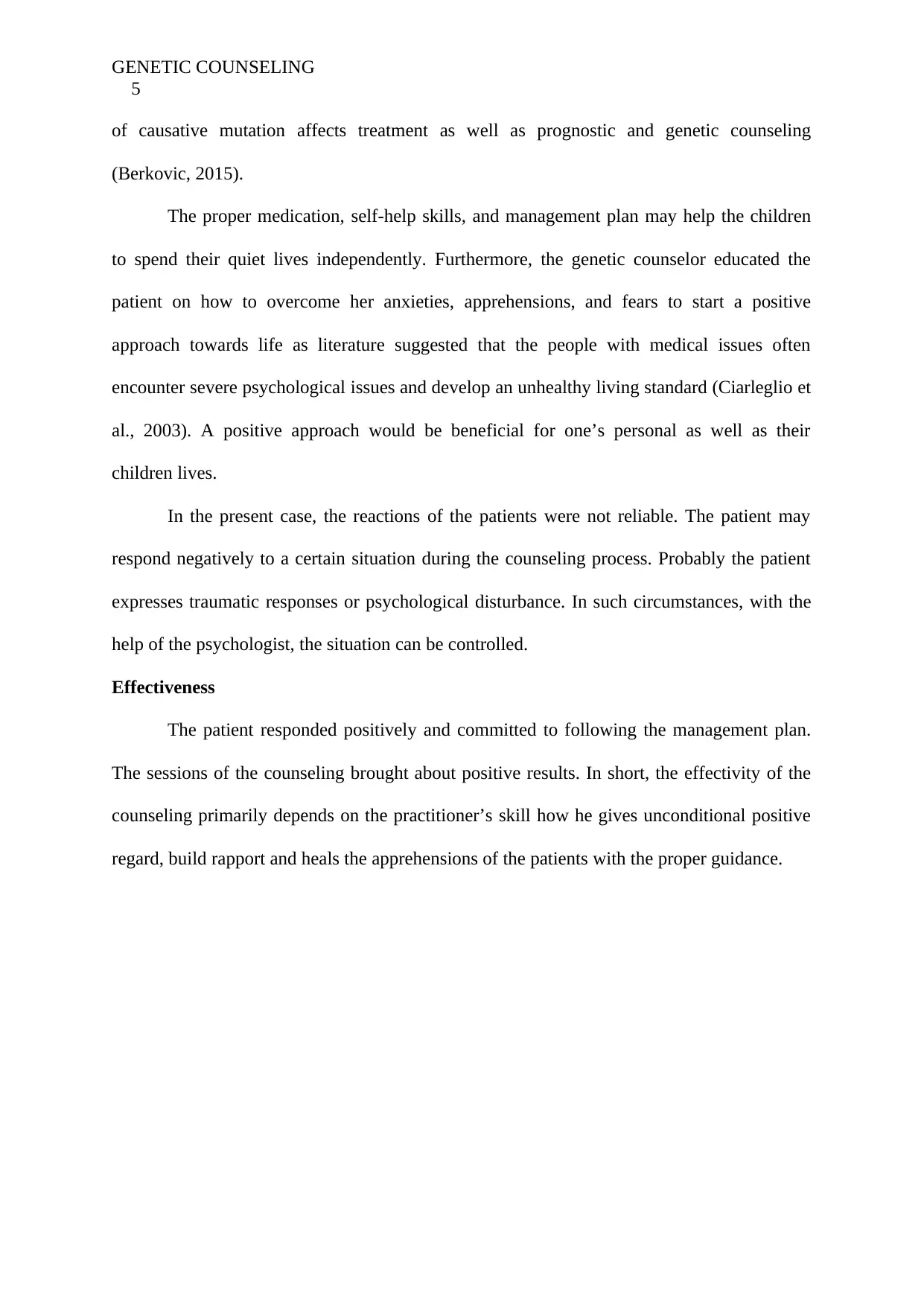
GENETIC COUNSELING
5
of causative mutation affects treatment as well as prognostic and genetic counseling
(Berkovic, 2015).
The proper medication, self-help skills, and management plan may help the children
to spend their quiet lives independently. Furthermore, the genetic counselor educated the
patient on how to overcome her anxieties, apprehensions, and fears to start a positive
approach towards life as literature suggested that the people with medical issues often
encounter severe psychological issues and develop an unhealthy living standard (Ciarleglio et
al., 2003). A positive approach would be beneficial for one’s personal as well as their
children lives.
In the present case, the reactions of the patients were not reliable. The patient may
respond negatively to a certain situation during the counseling process. Probably the patient
expresses traumatic responses or psychological disturbance. In such circumstances, with the
help of the psychologist, the situation can be controlled.
Effectiveness
The patient responded positively and committed to following the management plan.
The sessions of the counseling brought about positive results. In short, the effectivity of the
counseling primarily depends on the practitioner’s skill how he gives unconditional positive
regard, build rapport and heals the apprehensions of the patients with the proper guidance.
5
of causative mutation affects treatment as well as prognostic and genetic counseling
(Berkovic, 2015).
The proper medication, self-help skills, and management plan may help the children
to spend their quiet lives independently. Furthermore, the genetic counselor educated the
patient on how to overcome her anxieties, apprehensions, and fears to start a positive
approach towards life as literature suggested that the people with medical issues often
encounter severe psychological issues and develop an unhealthy living standard (Ciarleglio et
al., 2003). A positive approach would be beneficial for one’s personal as well as their
children lives.
In the present case, the reactions of the patients were not reliable. The patient may
respond negatively to a certain situation during the counseling process. Probably the patient
expresses traumatic responses or psychological disturbance. In such circumstances, with the
help of the psychologist, the situation can be controlled.
Effectiveness
The patient responded positively and committed to following the management plan.
The sessions of the counseling brought about positive results. In short, the effectivity of the
counseling primarily depends on the practitioner’s skill how he gives unconditional positive
regard, build rapport and heals the apprehensions of the patients with the proper guidance.
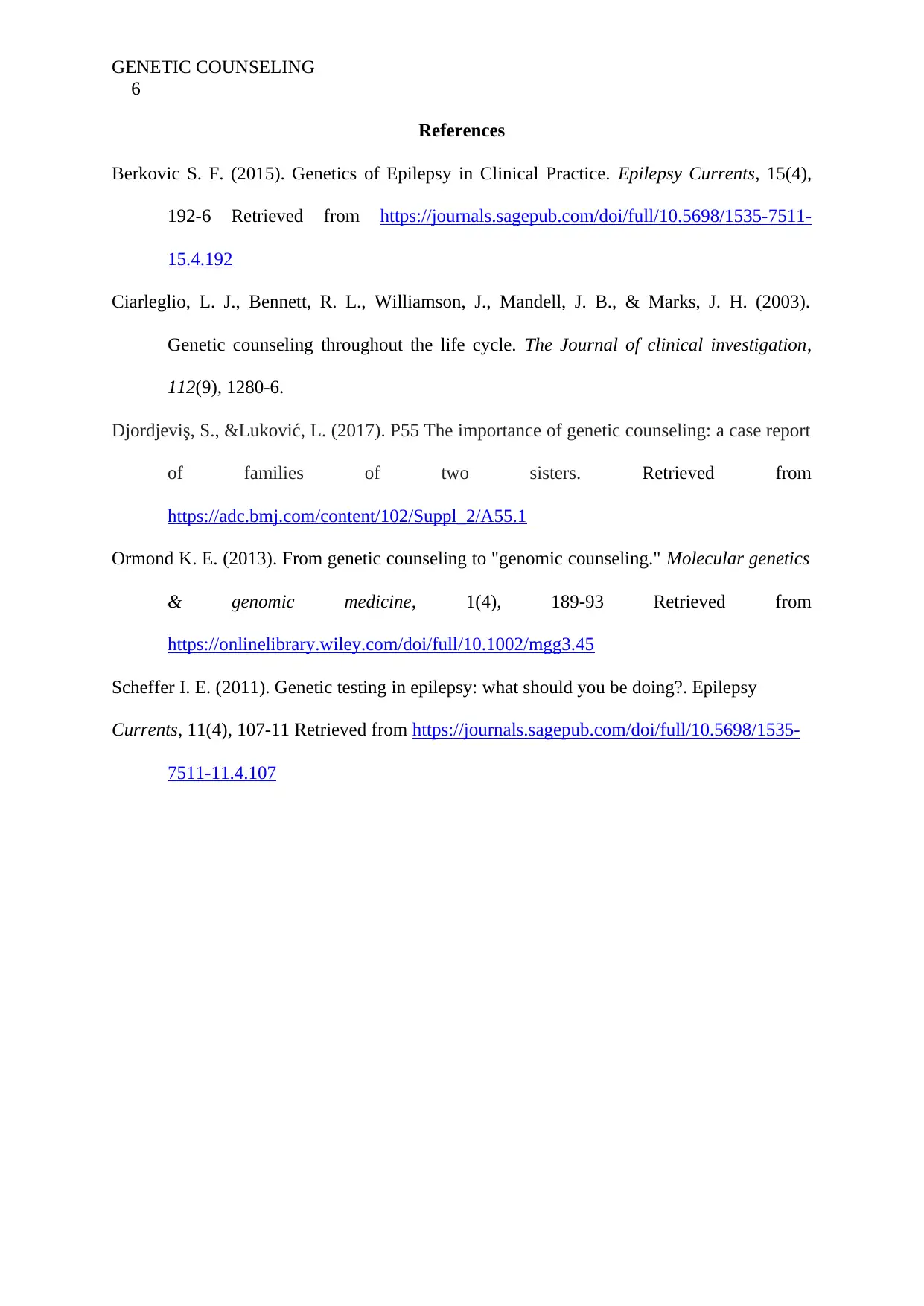
GENETIC COUNSELING
6
References
Berkovic S. F. (2015). Genetics of Epilepsy in Clinical Practice. Epilepsy Currents, 15(4),
192-6 Retrieved from https://journals.sagepub.com/doi/full/10.5698/1535-7511-
15.4.192
Ciarleglio, L. J., Bennett, R. L., Williamson, J., Mandell, J. B., & Marks, J. H. (2003).
Genetic counseling throughout the life cycle. The Journal of clinical investigation,
112(9), 1280-6.
Djordjeviş, S., &Luković, L. (2017). P55 The importance of genetic counseling: a case report
of families of two sisters. Retrieved from
https://adc.bmj.com/content/102/Suppl_2/A55.1
Ormond K. E. (2013). From genetic counseling to "genomic counseling." Molecular genetics
& genomic medicine, 1(4), 189-93 Retrieved from
https://onlinelibrary.wiley.com/doi/full/10.1002/mgg3.45
Scheffer I. E. (2011). Genetic testing in epilepsy: what should you be doing?. Epilepsy
Currents, 11(4), 107-11 Retrieved from https://journals.sagepub.com/doi/full/10.5698/1535-
7511-11.4.107
6
References
Berkovic S. F. (2015). Genetics of Epilepsy in Clinical Practice. Epilepsy Currents, 15(4),
192-6 Retrieved from https://journals.sagepub.com/doi/full/10.5698/1535-7511-
15.4.192
Ciarleglio, L. J., Bennett, R. L., Williamson, J., Mandell, J. B., & Marks, J. H. (2003).
Genetic counseling throughout the life cycle. The Journal of clinical investigation,
112(9), 1280-6.
Djordjeviş, S., &Luković, L. (2017). P55 The importance of genetic counseling: a case report
of families of two sisters. Retrieved from
https://adc.bmj.com/content/102/Suppl_2/A55.1
Ormond K. E. (2013). From genetic counseling to "genomic counseling." Molecular genetics
& genomic medicine, 1(4), 189-93 Retrieved from
https://onlinelibrary.wiley.com/doi/full/10.1002/mgg3.45
Scheffer I. E. (2011). Genetic testing in epilepsy: what should you be doing?. Epilepsy
Currents, 11(4), 107-11 Retrieved from https://journals.sagepub.com/doi/full/10.5698/1535-
7511-11.4.107
⊘ This is a preview!⊘
Do you want full access?
Subscribe today to unlock all pages.

Trusted by 1+ million students worldwide
1 out of 6
Related Documents
Your All-in-One AI-Powered Toolkit for Academic Success.
+13062052269
info@desklib.com
Available 24*7 on WhatsApp / Email
![[object Object]](/_next/static/media/star-bottom.7253800d.svg)
Unlock your academic potential
Copyright © 2020–2025 A2Z Services. All Rights Reserved. Developed and managed by ZUCOL.





